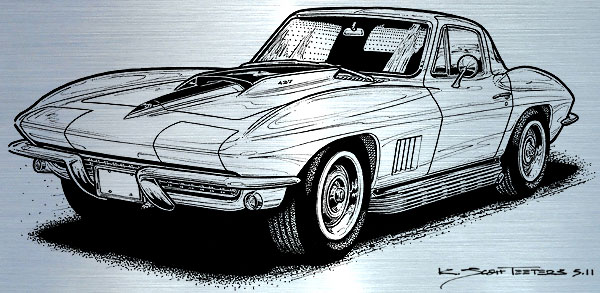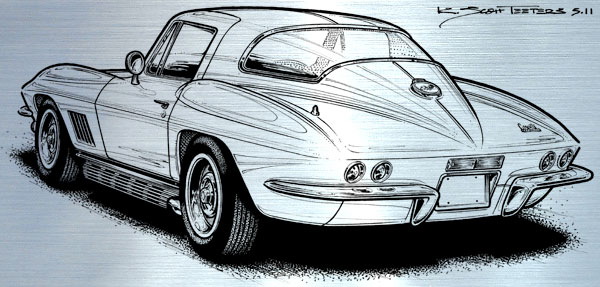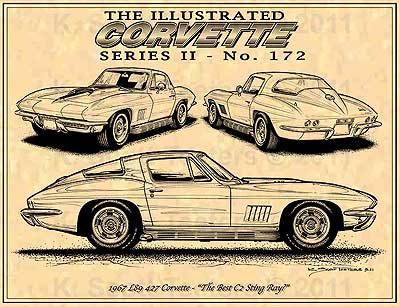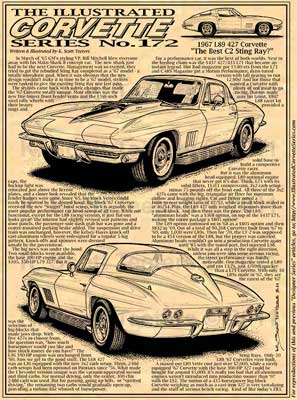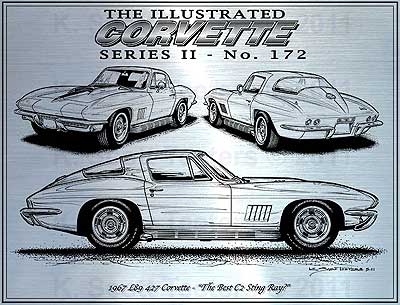Dateline: 7.28.2011
Was This The Best C2 Sting Ray?
In March of ‘65 GM’s styling VP, Bill Mitchell blew everyone away with his Mako Shark II concept car. The new shark just had to be the next Corvette. Management was so excited, they tried to get the rebodied Sting Ray completed as a ‘67 model – a totally unrealistic goal. When it was obvious that the new design wouldn’t make it in time to be a ‘67 model, stylists were tasked to give the existing Sting Ray one last pass.
The stylists came back with subtle changes that made the ‘67 Corvette totally unique. Most obvious was the new five-louver front fender vents and the 15×6-inch steel rally wheels with their beauty rings and caps, the backup light was relocated just above the license plates, and a closer look revealed that the fender badges were gone. Since ‘65, big-block Vettes could easily be spotted by the domed hood. Big-block ‘67 Corvettes received the new “Stinger” hood scoop, which is arguably the most popular performance car hood scoop of all time. While not functional, except for the L88 racing version, it just flat-out looks great! The interior had slightly revised seat patterns and door panels, the passenger-side dash grab bar was gone and a center-mounted parking brake added. The suspension and drive train was unchanged, however, the Kelsey-Hayes knock-off cast-aluminum wheels were redesigned for a regular 5-lug pattern. Knock-offs and spinners were deemed unsafe by the government.
The big news was under the hood. Two small-blocks were available, the base 300-HP engine and the $105, 350-HP L79 327. But it was the selection of big-blocks that made jaws drop. With five 427s to choose from, the question was, “how much horsepower would you like and how much money do you have?” The L36 390-HP engine was unchanged from ‘66. Now we get to the good stuff. The L68 427 was an L36 equipped with the new 3×2 carb setup. Three, 2-bbl carb setups had been optional on Pontiacs since ‘56. What made the Chevrolet version unique was the vacuum-opperated second and third carbs. For normal driving, only the center, 300 cfm 2-bbl carb was used. But for passing, going up hills, or “spirited driving,” the remaining two carbs would gradually open up, providing a turbine-like whoosh of horsepower.
For a performance car, it was the best of both worlds. Next in the feeding chain was the $437 427/435 L71 that became an instant legend. Hot Rod magazine got 13.80 ets from the L71 and CARS Magazine got a Motion Performance, dyno tuned version with tall gearing to run 12.90s! And for those that wanted a Corvette with plenty of red meat to go racing, Duntov made sure his latest, $947 L88 racer kit provided a solid base to build a competitive Corvette racer.
But it was the aluminum head-equipped, L89 optional engine that never got it’s due. Think, L71 with its solid-lifters, 11.0:1 compression, 3×2 carb setup – minus 75 pounds off the front end. All three of the 3×2 427s came with the big, triangular air fliter for maximun airflow and bragging rights. Car and Driver noted a front-to-rear weight ratio of 47/53, while a small-block scaled in at 46/54. Plus, the L89 427 only weighed 40-pounds more than a small-block. And then there was the price. The L89 “aluminum heads” was a $368 option, on top of the $437 L71, making the entire package a $805 option!
The L89 option continued on in ‘68 as a $805 option and then $832 in ‘69. Out of a total of 90,268 Corvettes built from ‘67 to ‘69, only 1,030 were L89s. Then for ‘70, the LT-2 was supposed to be a 454 version of the L88, but the project was canceled. Aluminum heads wouldn’t go into a production Corvette again until ‘85 with the tuned-port, fuel-injected L98. While it was all a step in the right direction, unless you were into some serious racing, the street performance was hardly noticeable. One magazine tested a L89 and ran 13.7s, just 1/10th quicker than a L71 Corvette. With only 16 L89s made in ‘67, they are the rarest of the ‘67 Sting Rays. Only 20 L88 ‘67 Corvettes were built.
A maxed out L89 Vette cost just over $7,000, while a nicely equipped ‘67 Corvette with the base 300-HP 327 could be bought for around $5,000. It’s really too bad that all-aluminum engines weren’t introduced into production sooner than ‘97 with the LS1. The notion of a 435-horsepower big-block Corvette weighing as much as a cast-iron 327 is very tantalizing and the stuff of serious bench racing. Kind of like today’s ZR1. – Scott
Parchment paper and laser-Etched prints of the below images are available HERE.


